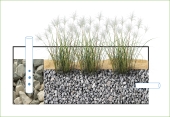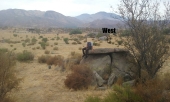




Mike Haasl wrote:Or make the bricks a bit smaller....




John C Daley wrote:I studied the water situation because you need a lot of it for cob or adobe.
The peninsula of Baja California in northwestern Mexico has few available water resources and is one of the most arid areas in Mexico.
The Tecate River is a sub-basin of the Tijuana River basin, a coastal watershed in Baja California adjacent to the USA-Mexico international border
that discharges into the Pacific Ocean (Figure 1). In 2000, the groundwater resources provided about thirty percent of Tecate’s potable water supply [1],
decreasing to only twenty percent in 2015 [2]. In addition, with the increase in population, urbanization, and industry in Tecate,
there is a concomitant increase in contaminants being introduced into the Tecate River and groundwater resources. The Tecate River,
which under natural conditions is an ephemeral stream, has become a perennial one with poor water quality downstream of the discharges.
I am worried it may be a big issue for you.


Rufus Laggren wrote:I have lived in Chicago, St. Louis and visited Charleston for a couple weeks. I have traveled extensively through the desert in temps of 100F. and more.
Charleston was the hardest with temps around 90-95F. and humidity over 90%.
Chicago was fairly livable with temps below about 98F. - depending on humidity. Desert travel in temps below about 105F AND in shade was not too much of a problem provided one had enough water - I usually drank more than a gallon a day and did not pee much.
What I'm saying is that for for _light_ activity in dry climate in "hard" shade (shade that does not re-radiate heat onto you) 105F. is not much of a problem. I did not make a habit of heavy labor in those conditions, though. Depending on your own personal experience and proclivities, you _may_ be good with "105F. in the shade".
The next thought is not about your rock. (GREAT rock, BYW!) I have experienced noticeable improvement in hot weather comfort when I can use a double layer of shade. In desert, my first, second and 3rd thought is SHADE. 1b,2b,3b is convective (moving air) between the primary shade and whatever makes a second ceiling for the personal space. The thing is, just putting up a sun barrier doesn't get you the huge benefit because the barrier material gets hot and the lower surface of it radiates DOWN and what is "down" there? You! To realize good shade, the lower surface of that shade needs to remain below about 80F. This is so it doesn't want so much to act like that fancy radiant heating people put into their walls and floors - to keep them warm! When erecting shade, one wants to try to arrange that the side toward you doesn't get too warm and _that_ may mean some kind of natural convective air flow across the bottom of your shade. No matter what makes up your shade.
I have done this semi-successfully with thick light colored canvas tarp over a smaller tent and eating area. The small tent (well ventilated) was actually cooler than the eating area even though it had somewhat less air flow. Inside the small ten there were two layers of shade between me and the sun and (this is the biggee) the small tent material was actually a comfy 85F. while the bottom of the primary shade tarp was easily over 100F. The primary shade tarp was still passing heat, it was just radiating in the infra-red instead of bright visible spectrum+UV from the sun (which it was protecting us from).
So. When creating shade, keep an eye for ways to help get rid of the heat added to the shade material itself. And plan on a second layer of shade to protect you if the primary layer is going to get hot. I think the Aussie's have something called a "summer roof" which is a top layer of tin or something that stops the sun which they install about 6" above the weather roof of their homes. The air space is open around edge and helps cool the "summer roof" to reduce it's radiation down onto their weather roof. It also prevents any heat transfer by conduction.
Or, natures way is with a few big trees in the right place to shade your home. Might be worth the years of water angst and sacrifice to see if you can deep irrigate some big shade trees and get them rooted good enough to survive the real world.
But that rock is truly inspiring. You have found "Presence" for sure.
Cheers,
Rufus

Dustin Rhodes wrote:This guy is doing a granite integrated cob building in San Diego County; here's the most recent episode(go back into his posting history to watch each step for tips):

Hugo Morvan wrote:How does that work in winter anyway? When you want your house warmer then the rock. Do you need to heat the rock or can you insulate it until summer hits.
Maybe in winter you could have a room further away from the rock passively heated on the south side. A room you use less in summer time.. with a veranda that only let’s the sun in when it’s low on the horizon..

John C Daley wrote: That is a fabulous rock, it may be best to use it as it is.
A cistern on top would be a distraction.
As suggested cob is a good medium to bond to the rock, although it needs more water than rammed earth would use.
Is there any clay in the area?
What will happen with water?.
Plants may be growing next to it because the rock will attract dew and thus moisture which will dribble to the ground.
I suggest it may be a better result to use it as a shelter object and leave the vegetation in place.
I live in a similar environment 45 deg C heat and dry climate.
A small thick walled home designed to exclude heat is something that works for me, with a safari shading roof over the roof and verandas for shade.
Having at least a 3 M ceiling height also helps.
If you plan it well, nothing needs to be pulled down as you extend the structure over time.
I have built a tall tower which draws air through the house, along to lines of middle eastern structures called wind towers.

Eliot Mason wrote:I totally understand the impulse to use that rock as a wall. I think its a great idea. If its really granite then you could sink some bolts into it as well and sort of use it as a foundation piece to hold the roof/walls.
A different idea is to actually build the house AROUND the rock. I know that might be larger than you are presently considering, but it might be worth some thought. By putting that mass inside the structure you have a huge thermal mass that you can, sort of, control. Alternately, if its used as a wall consider building a simple shade wall/roof to protect the rock from solar heating - anything you can do do keep that rock cool so it can soak up heat from inside your structure will be great.